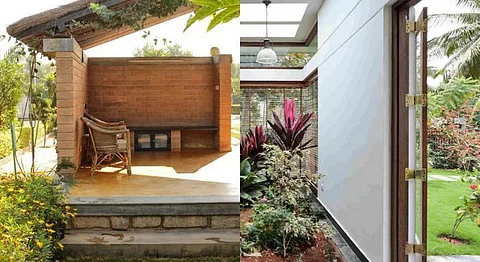8 Indian Architecture Firms That Marry Design & Sustainability
For years on end, we have taken immensely from nature with close to nothing offered in return. We exploited what was handed to us to look after, encroached upon the spaces of beings we should be coexisting with, and irreversibly damaged more than we can account for. Years ago, around the late 1980s, when the idea of sustainable thinking and action began to come about, we were possibly already a little too late in restoring our environment back to its complete luscious glory.
In 2017, a Global Status Report revealed that 39 per cent of the energy-related carbon dioxide emissions are due to the world’s building and construction activities. This large proportion of emission contribution, however, can be reduced by swapping the toxic modes of building construction with sustainable modes of construction. Sustainable architecture is a step towards consciously designing structures in a way that minimises the negative environmental impact created and is aware of judicious use of materials and surrounding ecology.
Sustainable designing requires the architect to think on a different tangent, away from traditional and popular methods. Having an eye for making the most of what is naturally available in a manner that avoids environmental and ecological disruption of the location is a must. But where can you find such minds? We have gathered a few architecture firms that strive for environmental efficiency in their projects that result in spectacular structures.
It is important for the people at Ashok B Lall Architects to address three main factors through their work — social inequity, cultural subversion, and environmental impact. Architecture here doesn’t limit itself to solely designing and constructing a structure. They ensure that their work carries a larger beneficial purpose. With a plan to use the most economical processes, they also strive to keep the client included at all steps of the way.
II. Biome Solutions
Covering all bases of sustainable design thinking, Biome Solutions keeps in mind multiple factors before they get started. Their consideration for the impact on land explores the local ecology, location and waterways and use them as methodically as possible. They lend quite a lot of importance to water conservation, not just in their processes, but also in ways their projects can minimise water wastage. Biome Solutions acknowledges and appreciates the contribution of each member, whether it be the architects themselves or the construction workers, and at later stages, energy efficiency, integrated water management, and their social responsibility.
III. Green Evolution
This Chennai-based architecture firm sternly believes in sustainable excellence through architecture. It is insufficient for them to serve just the client and believe that serving the environment is equally as important. Green Evolution considers sustainable architecture as a simple yet radical method to counter climate change, and rightly so, as a slightly different perspective on the same practices can lead to innovative designs that leave a positive impact. They do this through ‘sustainable strategies which result in longevity and value for investment.’
IV. Made In Earth
As the name suggests, Made In Earth takes its responsibly toward the planet quite seriously. Steering far from the over-exploitation of materials and making use of what is naturally available, the firm believes that architecture need not be over-the-top with improper use of resources and techniques. They use materials such as clay, lime and often include wood, stone, fly ash, straw and rice rusk in various forms through imaginative designs followed by effective execution.
In 2016, they designed three kiosks in Cubbon Park in Bangalore out of recycled palette wood, bamboo, earth and lime. Their ongoing projects include apartments, a college campus, and an experience centre.
Having worked with Laurie Baker, a pioneer in the sustainable architecture sphere, Malaksingh Gill aims to responsibly make use of his learning and continue working in a sustainable manner. His firm is based in Mumbai and deeply believes in catering according to the situation and surrounding, which oftentimes leads them to unlearning modern technologies and procedures and learning to go back to the roots of vernacular architecture. They believe that ‘architecture, just like the flora and fauna of a place has to spring from the place itself’ and we couldn’t have said it better ourselves. They carefully include local expertise with their forward-thinking ideas.
VI. Masons Ink
Built on the foundation of sustainability, heritage conservation and humanitarian architecture, Masons Ink is a Bengaluru-based architecture firm that believes sustainability should be the norm, rather than a choice. They strive to be as close to zero carbon-footprint in their projects as well. Additionally, they hold awareness programmes on sustainability and heritage. Masons ink is always on the lookout for efficient ways to use natural materials in construction.
Their work shows off their impressive designs- functional, appealing and mindful. Something about them will have you feeling closer to Earth than ever before.
VII. SHiFt
The Studio for Habitat Futures (SHiFt) leaves the traditional and harmful ways of designing and building in the past and focuses on design for the future. Their architecture projects are designed to consume lesser energy, use community-based design, and make use of earth construction. Their team consists of a multi-disciplinary mix that gives them a certain edge in the way they think, re-think, design and execute.
Their projects include IIT Delhi, IIT Jodhpur, Taj Safaris in Panna National Park, the Bamboo Research & Training Institute in Chandrapur, an open stadium in Leh and many more.
VIII. Wallmakers
Led by Vinu Daniels, Wallmakers have dedicated themselves to making extensive and proper use of mud and waste, just like our ancestors used to do before the advent of ‘cement houses’. Wallmakers’ designs various structures keeping in mind the local ecology and smartly integrate materials like compressed earth tiles and bamboo to make strong, complex and appealing structures. They do not shy away from using discarded materials as components that make the design seem complete.
If you enjoyed reading this, we suggest you read:


